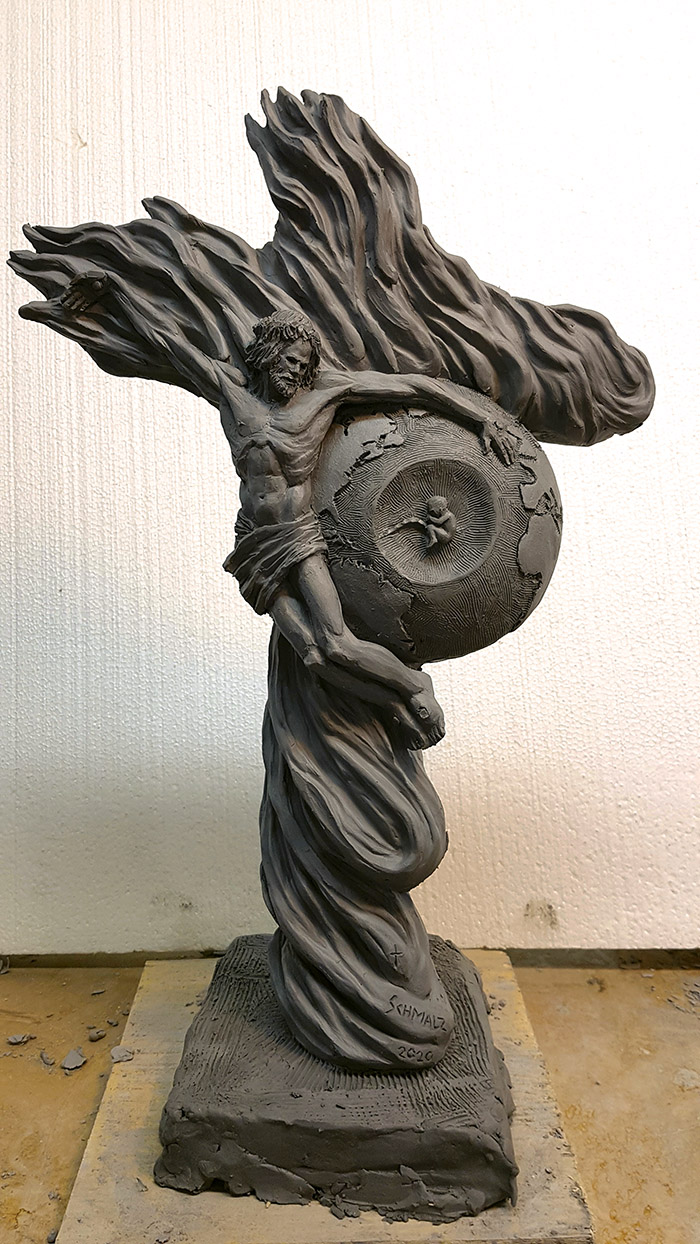It wasn’t literally Lucifer, but an image of the devil Schmalz had created for a project on Dante’s Inferno that he has worked on for the past year.
“Here I was, torn between finishing my last canto of Dante’s Inferno or doing a sculpture of Jesus,” said the St. Jacob’s, Ont.-based sculptor. “It’s been a tradition of mine for almost 20 years to every Easter create a sculpture of Jesus.”
The thing was, he had “absolutely no clue” what to do. It was 4 a.m. on Good Friday, a block of clay sitting in front of him and his mind was blank. It’s not the first time Schmalz has experienced this, and that helped ease his mind.
“It’s the time, as far as my own experience, where nothing comes to you, where you draw a blank, which is sometimes when the greatest artwork comes,” said Schmalz.
Three days later, in self-isolation in his studio, putting in the long hours and physical labour required for such work, he believes he came up with something special — a sculpture he’s called Jesus 2020. He sees it as perfect for a time the world is virtually shuttered as it deals with the COVID-19 pandemic.
“What unfolded within those three days was something fantastic as far as I can see,” said Schmalz, a renowned artist probably best known for his bronze Homeless Jesus that adorns churches and religious sites around the world, from the original at the Jesuit-run Regis College in downtown Toronto to Christ Church Cathedral in Dublin and the Sant’Egidio headquarters in Rome. “It’s Jesus on the cross and He is embracing the world and in the centre of the world is an unborn child. (There) is so many layers of symbolic meaning to that.”
 Canadian sculptor Timothy Schmalz’ latest creation is Jesus 2020. (Photo courtesy Timothy Schmalz)
Canadian sculptor Timothy Schmalz’ latest creation is Jesus 2020. (Photo courtesy Timothy Schmalz)
There is the pain and suffering of Christ, much like what is happening worldwide with the COVID-19 crisis. The cross in flames shows a world in a state of jeopardy, but Christ’s embrace of the world, with the fetus at its centre, is witness to love and Christian compassion, said Schmalz. The child is the link to everything else in the world.
“To me, the unborn fetus represents all of humanity and is yet to be born,” he said. “It’s like the world is a precious child, but also the links between all the other issues and the idea of pro-life, they’re all intertwined.”
These symbols, when all taken in, show that positive spiritual things can come if we are awakened and aware.
“The flaming cross, the world being embraced by Jesus who has compassion in His face really becomes to me, and hopefully others, a symbol of throughout this time we need to have faith and we need to trust the compassion of Christ,” said Schmalz.
He’s ecstatic with what he accomplished in just three days.
“It’s a great time to surrender your own will to God,” he said. “God of surprises, that’s what I have to say. As long as you are open to the surprises that might come out, that’s fine.”
Now that the model is set, he’s not sure when the final product will be complete. He is still wrapped up in other projects like his human trafficking sculpture and finishing the Purgatory piece of his Dante project. But Schmalz is hoping it will be a “positive monument” to this pandemic experience.
“Symbols are important and you never know how symbols come about,” he said.

